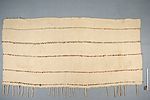swoqw'elh (Chief's Blanket)
About this object
History of use
Mountain goat wool blankets worn as robes or used as bedding were marks of high social status. The blankets were objects of wealth, and were presented as gifts on ceremonial occasions. Presentations were made in the exchanges that accompanied weddings. They were also used to compensate shamans and other specialists for their services. They were distributed to those who witnessed weddings, naming ceremonies, and memorial rituals. The dead of wealthy families were wrapped in blankets. By the 1850s, Hudson Bay point blankets, and other trade blankets were beginning to supercede the ones woven locally. Women underwent ritual purification before beginning work with mountain goat wool, and some had guardian spirits who gave superior skills in weaving.
Cultural context
ceremonial; status; wealth
Specific techniques
Mountain goat wool was gathered from bushes or from prepared hides, and a clay-like material was mixed into it. Dog hairs and other animal hairs, as well as various plant fibres sometimes supplemented the goat wool. In general, wool was spun on a large spindle which was inserted into a disc-shaped spindle whorl. Earlier blankets use natural dyes to create brown or black stripes when desired; later ones often contained stripes of brightly coloured material from trade cloth, such as red flannel. Blankets were produced on two-bar warp frames; yarn was wound around the two bars to produce a continuous warp. Twill weave was used for the blankets: the weft is carried over and under the warp threads at different intervals, creating a diagonal texture, which may be varied to create different patterns. Feathers (eagle down?) and human hair woven into blanket; human hair was woven into blankets for protection.
Physical description
Soft loosely-woven blanket in twill weave, using undyed, handspun wool. Five narrow strips of black and coloured wool and cloth are woven across the entire width. A widely spaced, twisted wool fringe hangs along the bottom edge, although some are missing.
Categories
